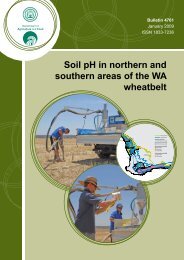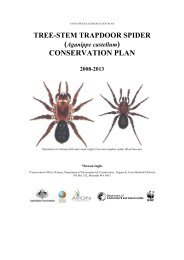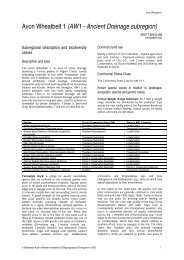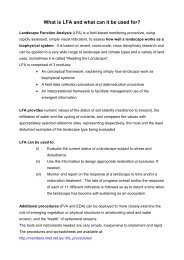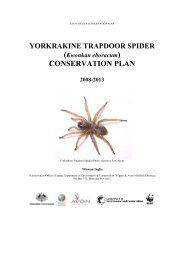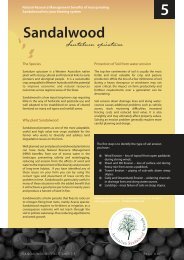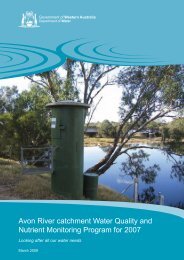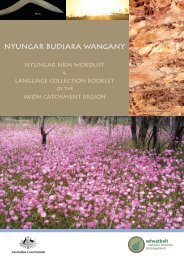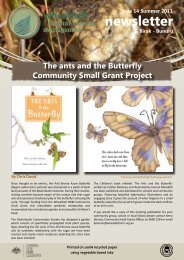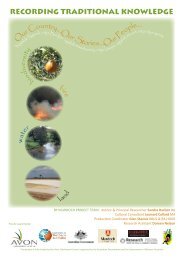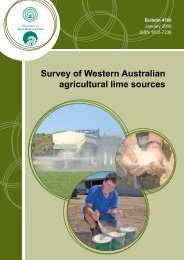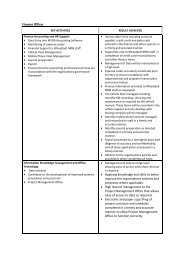Kokerbin Nature Reserve Desktop Fauna ... - Wheatbelt NRM
Kokerbin Nature Reserve Desktop Fauna ... - Wheatbelt NRM
Kokerbin Nature Reserve Desktop Fauna ... - Wheatbelt NRM
You also want an ePaper? Increase the reach of your titles
YUMPU automatically turns print PDFs into web optimized ePapers that Google loves.
<strong>Kokerbin</strong> <strong>Nature</strong> <strong>Reserve</strong><br />
<strong>Desktop</strong> <strong>Fauna</strong> Assessment<br />
Appendix 2. Categories used in the assessment of<br />
conservation status.<br />
IUCN categories (based on review by Mace and Stuart 1994) as used for the<br />
Environmental Protection and Biodiversity Conservation (EPBC) Act and the<br />
WA Wildlife Conservation Act.<br />
CATEGORY<br />
DEFINITION<br />
Extinct. Taxa not definitely located in the wild during the past 50<br />
years.<br />
Extinct in the Wild. Taxa known to survive only in captivity.<br />
Critically Endangered. Taxa facing an extremely high risk of extinction in the wild in<br />
the immediate future.<br />
Endangered.<br />
Taxa facing a very high risk of extinction in the wild in the<br />
near future.<br />
Vulnerable.<br />
Taxa facing a high risk of extinction in the wild in the<br />
medium-term future.<br />
Near Threatened. Taxa that risk becoming Vulnerable in the wild.<br />
Conservation Dependent. Taxa whose survival depends upon ongoing conservation<br />
measures. Without these measures, a conservation dependent<br />
taxon would be classed as Vulnerable or more severely<br />
threatened.<br />
Data Deficient<br />
Taxa suspected of being Rare, Vulnerable or Endangered, but<br />
(Insufficiently Known). whose true status cannot be determined without more<br />
information.<br />
Least Concern.<br />
Taxa that are not Threatened.<br />
Definitions of relevant categories under the EPBC Act.<br />
CATEGORY<br />
Endangered<br />
(EN)<br />
Vulnerable<br />
(VU)<br />
Migratory<br />
(M)<br />
DEFINITION<br />
The species is likely to become extinct unless the circumstances and<br />
factors threatening its abundance, survival or evolutionary development<br />
cease to operate; or its numbers have been reduced to such a critical<br />
level, or its habitats have been so drastically reduced, that it is in<br />
immediate danger of extinction.<br />
Within the next 25 years, the species is likely to become endangered<br />
unless the circumstances and factors threatening its abundance, survival<br />
or evolutionary development cease to operate.<br />
Species are defined as migratory if they are listed in an international<br />
agreement approved by the Commonwealth Environment Minister,<br />
including:<br />
• the Bonn Convention ((Convention on the Conservation of<br />
Migratory Species of Wild Animals) for which Australia is a<br />
range state;<br />
• The Agreement between the Government of Australia and the<br />
Government of the Peoples Republic of China for the Protection<br />
of Migratory Birds and their Environment (CAMBA); or<br />
• The Agreement between the Government of Japan and the<br />
Government of Australia for the Protection of Migratory Birds<br />
and Birds in Danger of Extinction and their Environment<br />
(JAMBA).<br />
50



